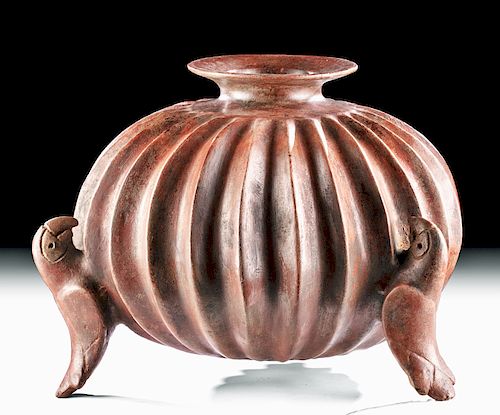Colima Redware Gadrooned Parrot Vessel, ex Sotheby's
Lot 116
About Seller
Artemis Fine Arts
686 S Taylor Ave, Ste 106
Louisville, CO 80027
United States
Selling antiquities, ancient and ethnographic art online since 1993, Artemis Gallery specializes in Classical Antiquities (Egyptian, Greek, Roman, Near Eastern), Asian, Pre-Columbian, African / Tribal / Oceanographic art. Our extensive inventory includes pottery, stone, metal, wood, glass and textil...Read more
Categories
Estimate:
$8,000 - $12,000
Absentee vs Live bid
Two ways to bid:
- Leave a max absentee bid and the platform will bid on your behalf up to your maximum bid during the live auction.
- Bid live during the auction and your bids will be submitted real-time to the auctioneer.
Bid Increments
| Price | Bid Increment |
|---|---|
| $0 | $25 |
| $300 | $50 |
| $1,000 | $100 |
| $2,000 | $250 |
| $5,000 | $500 |
| $10,000 | $1,000 |
| $20,000 | $2,500 |
| $50,000 | $5,000 |
| $100,000 | $10,000 |
| $200,000 | $20,000 |
About Auction
By Artemis Fine Arts
Feb 13, 2020
Set Reminder
2020-02-13 10:00:00
2020-02-13 10:00:00
America/New_York
Bidsquare
Bidsquare : Exceptional Antiquities, Asian, Ethnographic
https://www.bidsquare.com/auctions/artemis-gallery/exceptional-antiquities-asian-ethnographic-4848
An important one-day auction featuring museum-worthy examples of Egyptian, Greek, Roman, Etruscan, Near Eastern, Far East / Asian, Pre-Columbian, African / Tribal, Oceanic, Native American, Spanish Colonial, Russian, Fossils, Ancient Jewelry, Fine Art, so much more! Artemis Fine Arts info@artemisgallery.com
An important one-day auction featuring museum-worthy examples of Egyptian, Greek, Roman, Etruscan, Near Eastern, Far East / Asian, Pre-Columbian, African / Tribal, Oceanic, Native American, Spanish Colonial, Russian, Fossils, Ancient Jewelry, Fine Art, so much more! Artemis Fine Arts info@artemisgallery.com
- Lot Description
Pre-Columbian, West Mexico, ca. 300 BCE to 300 CE. This brilliant vermillion pottery vessel is in the form of a wide, voluminous squash with a body that is stylistically segmented with smooth, fine vertical ribbing, with a boldly flaring spout, and all supported by three legs in the form of parrots, birds prized for their feathers among the ancients of America. Each avian form is defined with incised and pierced ovoid eyes, curved beaks, and incised and modeled wings upon a plump body that resolves to a tapered tail. The slipped and burnished surface is truly magnificent. Moreover, art imitates life in this ceramic vessel! After all, the indigenous of Mexico used hollowed gourds for storing and serving food and drink. Furthermore, iconographically this piece is quite poignant as squashes and parrots were both symbols of fertility and abundance. A stunning redware finish with areas of scattered root marks and numerous manganese blooms. Larger and finer than most! Size: 13.375" W x 9.875" H (34 cm x 25.1 cm)
Provenance: private New York, USA collection (begun in 1966); ex Lands Beyond Gallery; ex Sotheby's March 2005
All items legal to buy/sell under U.S. Statute covering cultural patrimony Code 2600, CHAPTER 14, and are guaranteed to be as described or your money back.
A Certificate of Authenticity will accompany all winning bids.
We ship worldwide and handle all shipping in-house for your convenience.
#151393Professionally repaired from several large pieces with restoration over the break lines (most repairs to rim and parrot legs). Minor surface wear/abrasions to high-pointed areas commensurate with age. Nice scattered manganese deposits.Condition
- Shipping Info
-
All shipping is handled in-house for your convenience. Your invoice from Artemis Gallery will include shipping calculation instructions. If in doubt, please inquire BEFORE bidding for estimated shipping costs for individual items.
-
- Buyer's Premium



 EUR
EUR CAD
CAD AUD
AUD GBP
GBP MXN
MXN HKD
HKD CNY
CNY MYR
MYR SEK
SEK SGD
SGD CHF
CHF THB
THB















